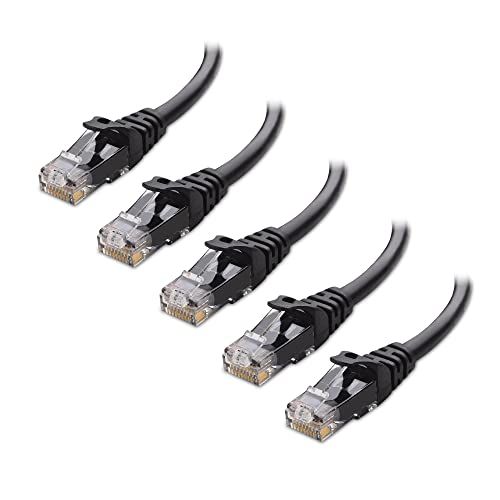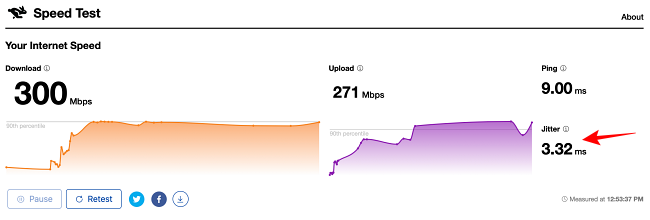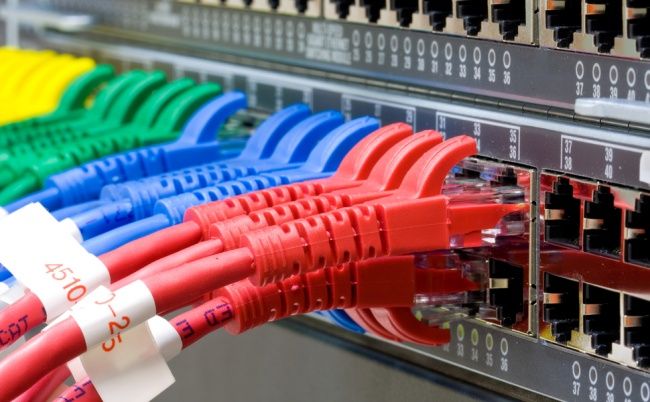Quick Links
When you run an internet speed test, the results can sometimes include a measurement for jitter. Why does it matter, and can it impact your internet performance? Here's everything you need to know.
Inconsistent Delay in Data Packets
Modern computer networks, like the internet, use data packets to transmit information from one place to another. These data packets are sent in a continuous stream, spaced evenly apart. But if, for some reason, such as network congestion, poor hardware, or lack of packet prioritization, the steady stream of data packets gets disrupted, and the interval between the packets gets uneven, the result is jitter. Simply put, jitter is the variation in the internal between successive data packets. It's also referred to as packet delay variation (PDV).
Jitter can lead to poor experience, particularly in real-time applications, such as video conferencing, VoIP calls, live streaming, online gaming, and more. You will notice it in the form of video or audio artifacts, static, distortion, and dropped calls.
Measuring Jitter
You can check the jitter of your internet connection by using speed test tools from Cloudflare or Ookla. The Cloudflare Speed Test tool is available via any modern browser, and apart from jitter, it will also inform you about your connection's download speed, upload speed, and ping time.
On the other hand, although Speedtest by Ookla is accessible via web browsers, jitter testing is only available in official Speedtest apps for Android, iPhone or iPad, Mac, and Windows.
Beyond Cloudflare and Ookla tools, Packet Loss Test developed by Matthew Miner is a more advanced tool that can identify jitter in your connection. It is very customizable and allows you to tweak packet size, frequency, duration, and acceptable delay. But if you are unsure about these customizations, you can also pick a preset. The available presets include full-HD cloud gaming streams, Zoom calls, VoIP calls, popular online games, and more. The results will reveal details about the average jitter, among other things.
What Is Acceptable Jitter?
Jitter is measured in milliseconds (ms), like ping or latency. Lower jitter scores mean you have a reliable and consistent connection, whereas higher jitter is the result of an inconsistent connection.
30ms of jitter or less is generally acceptable. But some applications can have a higher or lower tolerance for jitter. For example, suppose you are streaming video from Netflix or Disney+. In that case, you won't typically notice the effects of jitter because data flow is mostly one-directional. The streaming service can have a large buffer to mitigate any jitter. Similarly, jitter rarely impacts general web browsing, emails, social media, or using services like Google Docs unless it's extreme.
But, in the case of a video conference, a VoIP call, or an online gaming session---where communication between two or more endpoints is critical---jitter can easily play spoilsport. So very low to no jitter is preferred in such applications.
If jitter testing has revealed a figure over 30ms, and if you frequently use an application where it can impact performance, you will need to fix the underlying issue, or risk degraded performance.
How to Mitigate Jitter
Once you have identified that your connection has a significantly higher jitter and you are having problems, you can take a few steps to mitigate the issue.
A wired connection is one of the easiest ways to deal with jitter in your network. If you use a desktop or have a fixed working location, it's better to opt for an Ethernet cable to connect to the internet rather than Wi-Fi. Additionally, it's also a good idea to upgrade from Cat5 or older Ethernet cables to Cat6 or newer. Newer cables have more bandwidth and better protections from interference and crosstalk.

Cable Matters 5-Pack Ethernet Cables
These Cable Matters Ethernet cables fully meet the Cat6 specification and are available in a variety of sizes.
But if you have to rely on a wireless connection, it may be worthwhile to upgrade your wireless router. Many of the best wireless routers on the market have Quality of Service (QoS) technology that can manage your data traffic to prioritize critical apps and reduce jitter in their connection.
If possible, you should also reduce unnecessary bandwidth usage, like Netflix streaming, while running critical apps. Additionally, you can schedule device or software updates outside work hours to free up bandwidth for essential tasks.
If you still have jitter issues, it's time to contact your internet service provider (ISP). For example, you may have a problem with last mile connectivity, or you may need to upgrade your plan. But if nothing works, your final option is switching ISPs (which may or may not be possible depending on where you live).
Does Jitter Affect Internet Speed?
Jitter doesn't directly impact your internet speed but can affect your internet performance. So jitter and internet speed go hand in hand. When your network jitter is very high, it can seem like you are having internet speed issues because of choppiness, delay, and artifacts in the apps you use. But by using a wired connection, upgraded hardware, and proper network configuration, you can militate jitter and improve the overall internet performance.



